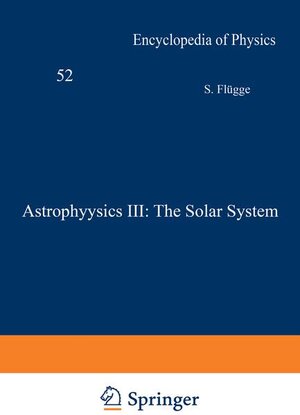
×
![Buchcover ISBN 9783540024163]()
Astrophysics III: The Solar System / Astrophysik III: Das Sonnensystem
von S. FlüggeInhaltsverzeichnis
- The Photosphere of the Sun.
- I. The continuous spectrum.
- a) Solar constant.
- b) Observed limb darkening.
- c) Observed solar energy distribution.
- d) Observational models of the photosphere.
- II. The Fraunhofer spectrum.
- a) Observational data.
- b) The formation of Fraunhofer lines.
- c) The analysis of Fraunhofer lines.
- General references.
- Structure and Dynamics of the Solar Atmosphere.
- A. The undisturbed photosphere and chromosphere.
- I. The undisturbed photosphere.
- a) Granulation.
- b) Temperature and density inhomogeneities in the photosphere.
- c) Micro- and macro-turbulence in the photosphere.
- d) Theory of convection and turbulence in the solar atmosphere.
- II. The chromosphere.
- a) The chromosphere at the limb.
- b) The chromosphere on the disk.
- c) Structure and dynamics of the chromosphere; transition to the corona.
- B. The disturbed parts of the photosphere and chromosphere.
- I. Sunspots.
- a) The individual spots.
- b) Group of spots.
- II. Photospheric and chromospheric faculae.
- a) The faculae proper.
- b) The “centre of activity”.
- III. Flares and associated phenomena.
- a) Monochromatic observations.
- b) Spectrographic observations.
- c) Dynamical phenomena associated with flares.
- IV. Filaments and prominences.
- a) The quiescent prominences.
- b) Moving prominences.
- C. The corona.
- I. Optical observations.
- a) The quiet minimum corona; photometry, ionization and excitation.
- b) The structure of the quiet minimum corona; temperatures and densities.
- c) The active parts of the corona and the “maximum corona”.
- II. Radio emission from the Sun.
- a) The quiet Sun.
- b) Thermal radiation from centres of activity.
- c) Non-thermal radiation: type III and type U bursts.
- d) Other non-thermal radiophenomena, often connected with flares.
- D. Solar rotation and the solar cycle.
- a) The solar cycle.
- b) Solar rotation and the Sun’s general magnetic field.
- E. Solar and terrestrial relationship.
- The Atmospheres of the Planets.
- I. Introduction.
- II. The Earth’s atmosphere.
- III. The atmosphere of Venus.
- IV. The atmosphere of Mars.
- V. The atmospheres of Mercury and the Moon.
- VI. The atmospheres of major planets and their satellites.
- VII. Conclusions.
- Acknowledgment.
- References.
- Planetary Interiors.
- I. The mass-radius relation of cold bodies.
- II. Empirical features of the planets.
- III. Structure and composition of the planets.
- a) The constitution of the terrestrial planets.
- b) The constitution of the jovian planets.
- Radio Echoes from Sun, Moon and Planets.
- I. Strength and characteristics of echoes.
- II. Moon echoes.
- III. Future possibilities.
- IV. The Earth’s immediate neighbourhood.
- Die Kometen.
- I. Einleitung.
- II. Kometenbahnen.
- III. Spektren und Physik der Kometen.
- IV. Zur Deutung der Kometenformen.
- V. Kosmogonie der Kometen.
- Meteors.
- 1. Introduction.
- 2. Basic theory of the meteoric processes.
- 3. Meteor spectra.
- 4. Meteor dynamics and orbits of comets, asteroids, and meteors.
- 5. Meteoritic dust.
- 6. Visual meteor studies.
- 7. Radio meteor techniques.
- 8. Photographic meteor techniques.
- 9. The masses and densities of meteoroids.
- 10. Shower meteors.
- 11. Sporadic meteors and the total influx.
- 12. Origin of meteors, fireballs and meteorites.
- 13. Meteorites.
- Acknowledgments.
- Sachverzeichnis (Deutsch/Englisch).
- Subject Index (English/German).




